The Versatile Appeal of Self-Adhesive Wall Hooks
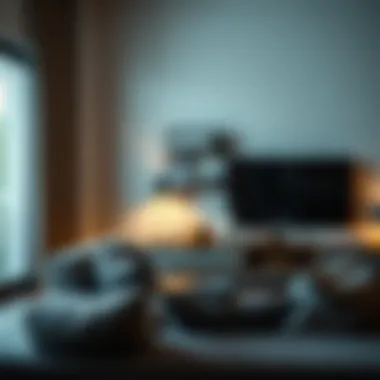
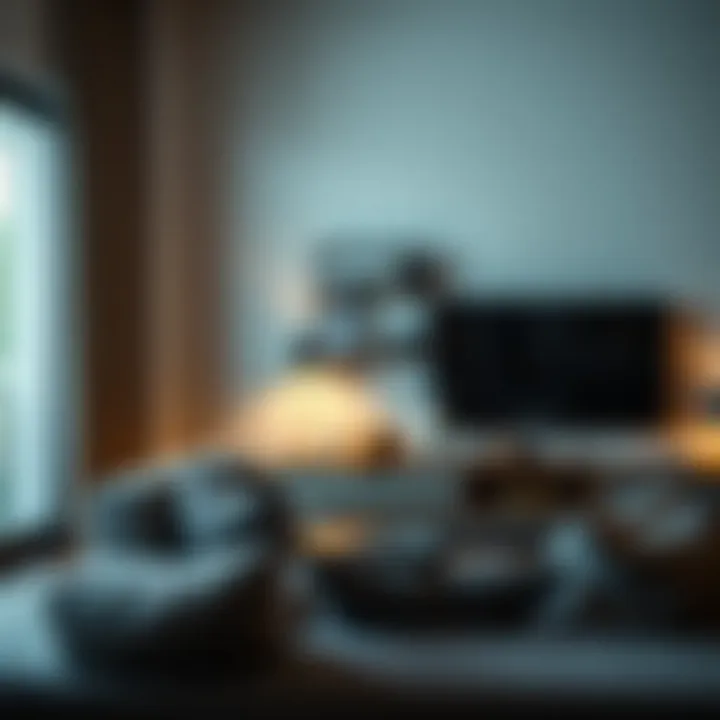
Intro
Self-adhesive wall hooks have become a staple in modern home organization and decor, providing a unique blend of utility and style. In today's fast-paced world, where more people are living in smaller spaces, the need for versatile storage solutions has only grown. These clever little tools serve more than just a functional purpose — they also add a touch of creativity and personalization to any room. As we explore the practicality and design of self-adhesive wall hooks, several key factors come to mind, including their various applications, installation techniques, weight capacities, and aesthetic contributions to our living areas.
The modern consumer is no longer content with utilitarian designs. Instead, there is a growing demand for products that harmonize form and function, something that self-adhesive hooks embody perfectly. Not only do they come in a range of styles, colors, and materials, but they also cater to every possible need: from hanging kitchen utensils to displaying cherished artwork. By diving into the trends and characteristics of these hooks, this article aims to provide a comprehensive view of how self-adhesive wall hooks can enhance both organization and ambiance within contemporary living environments.
Prolusion to Self-Adhesive Wall Hooks
Self-adhesive wall hooks have carved out a notable niche in the realm of home organization and design, combining functionality with a dash of creativity. The days of unsightly nail holes and cumbersome installation processes are, for the most part, behind us. These clever little devices not only save time but also contribute to a more polished look in any living space. They flourish in a variety of environments, from cozy homes to bustling offices, showcasing their versatility and appeal.
When pondering how to enhance your space without the mounting chaos, self-adhesive wall hooks emerge as a solution that’s hard to overlook. They offer a practical way to give every item its designated place, from keys and bags to decorative art pieces. Importantly, they allow for a more flexible approach to layout and design, accommodating changing tastes or needs without too much fuss.
Moreover, self-adhesive hooks can be an aesthetic asset, contributing significantly to the interior design narrative of a room. They range in styles, materials, and colors—each offering distinct flair and elegance. Whether your preference leans towards modern minimalism or warmer vintage vibes, there’s a hook that fits the bill.
Yet, as with any product, it's essential to consider the pros and cons. The convenience of installation, for instance, is countered by the need for proper application technique to ensure longevity. Additionally, understanding their load capacities can prevent mishaps, ensuring that your design remains as functional as it is beautiful.
In summary, this section serves as the foundation for exploring self-adhesive wall hooks. It sets the stage for a deeper dive into their definition, historical evolution, various types, and the myriad ways they can enhance both utility and visual appeal in our spaces.
Types of Self-Adhesive Wall Hooks
Understanding the different types of self-adhesive wall hooks is central to making informed choices regarding utility and design in both home and workspace settings. Each type brings its own set of features tailored to various needs and aesthetics, making their study essential for those wanting to enhance their spaces. It's not just the hook itself; it's also about what material it’s made from and the design choices we make.
Material Composition
Plastic
Plastic wall hooks offer a lightweight and often cost-effective solution for various hanging needs. One of their standout characteristics is the versatility in style and color; it’s almost like you're mixing and matching a wardrobe for your walls. Most importantly, plastic has a low weight tolerance, making it a reliable option for items like keys or small decorations.
However, the very same lightweight quality can be a double-edged sword. They aren't typically made for heavy-duty applications. If a plastic hook is overloaded, it might find itself on the floor before you know it. So, while plastic wall hooks can serve effectively in less demanding situations, caution about what gets hung can save frustrations down the line.
Metal
Metal hooks radiate a sense of robustness and durability, often designed to withstand significantly more weight than their plastic counterparts. Their strongest selling point is the inherent strength, making them ideal for larger items like coats or bags. You’ll find them a hit in environments where sturdiness is required, such as entryways or workshops.
The downside? Metal hooks are often heavier and may require a bit more care during installation to ensure they adhere properly without damaging your surfaces. Moreover, their aesthetic might clash with a softer interior design, so they’re best suited for a more industrial feel—or when you want to make a statement.
Wood
Wood wall hooks bridge the gap between aesthetics and utility like few other materials can. Their textured surface and natural hues offer a warmth that plastic and metal can’t easily match. In terms of design, wooden hooks can complement rustic or traditional decor splendidly. Not just for looks, they generally provide commendable weight capacity for items like jackets or tools.
However, wood does come with its own baggage. It might be susceptible to moisture damage, which means they’re not always the best option for high-humidity areas like bathrooms or kitchens. Still, when you consider their visual appeal and functionality, wooden hooks can be a charming addition to almost any space.
Design Variations
Minimalist Style
The minimalist design approach emphasizes simplicity and clean lines—perfect for a contemporary or Scandinavian-style space. Minimalist hooks often come in neutral colors and shapes that do not distract from the overall decor. This type ensures that the functionality of the hook does not overshadow the aesthetic elements of the room.
Ideal for those who appreciate subtlety, these hooks blend seamlessly into the background while still serving their purpose faithfully. However, while their simplicity can be a strength, it can also limit versatility, as some may find them less visually striking compared to more elaborate designs.
Decorative Options
On the other end of the spectrum, decorative wall hooks aim to serve both form and function. With intricate designs or vibrant colors, these hooks double as art pieces, adding personality to a space. Their versatility allows them to fulfill multiple roles—from a practical solution for hanging items to enhancing the overall aesthetic.
The potential pitfall is that they can sometimes clash with the rest of the room's decor if not chosen carefully. Thus, while decorative hooks can uplift an area, thoughtful coordination with existing aesthetics is crucial.
Functional Designs
Functional designs prioritize usability without entirely sacrificing style. These hooks often come with features that cater to specific needs—think hooks with multiple prongs for even more hanging spaces, or hooks designed for specific items like umbrellas or bags. This thoughtful approach signifies a balance between utility and visual appeal.
While effective, such hooks can sometimes come off as overly functional or industrial. Hence, users should experiment with these styles, ensuring they can maintain an overall cohesive look in their spaces while harnessing the full potential of their functionality.
Wall hooks don't just hang your stuff—they can also define your space's character.
Benefits of Using Self-Adhesive Wall Hooks
Self-adhesive wall hooks have carved out a niche in the home improvement and interior design world, proving their worth far beyond simple utility. These unassuming little tools offer a plethora of advantages that not only simplify organization but also amplify the aesthetic appeal of a space. Understanding the benefits of using self-adhesive wall hooks can foster a sense of practicality and style in every setting.
Ease of Installation
The simplicity of installation makes self-adhesive wall hooks a favored choice for anyone looking to add functionality to their space without the hassle of traditional hardware. Unlike nails or screws, which require tools and often lead to frustration, these hooks come equipped with adhesive that only necessitates a clean surface and a firm press to secure them in place. This ease allows even those who are less handy to affix hooks where needed, transforming a blank wall into a functional area in no time.
It’s worth noting that a little preparation goes a long way. Ensuring that the wall is dust-free and dry not only supports a better bond but also guarantees longevity. In places like kitchens and bathrooms, where humidity can be high, selecting high-quality self-adhesive hooks specifically designed for such environments can preserve their grip for a more extended period.
Non-Damaging to Walls
One of the standout features of self-adhesive wall hooks is their ability to provide functionality without damaging the paint or surface. Traditional hooks often lead to unsightly holes or chips, remnants of organization efforts that can haunt the aesthetics of a room for ages. In contrast, self-adhesive hooks peel off without leaving residue, allowing for relocation or removal without a second thought.
This quality becomes particularly relevant in rental properties where tenants must ensure they leave the space untouched. For homeowners as well, it represents a commitment to maintaining the properties pristine, allowing them to change decor or organization strategies without worry.
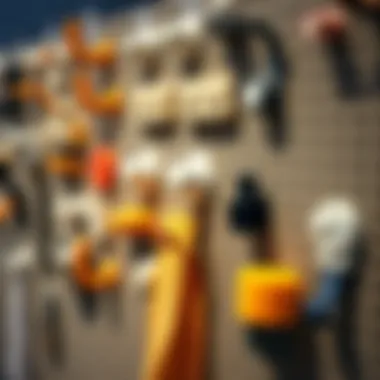

Versatility in Use
The versatility of self-adhesive wall hooks truly shines when considering their multiple applications across various settings. They are not confined to just one area of the home but instead can be utilized in homes, offices, and commercial spaces, each offering unique benefits depending on the environment.
Home
In a home setting, self-adhesive wall hooks can help create an organized entrance. They can hold bags, keys, or coats — keeping everything accessible while reducing clutter. The visual appeal is equally important; a well-placed hook can complement home décor, whether it's rustic or modern. Many designs available cater to various aesthetic preferences, ensuring that functionality and style go hand in hand. Households can count on the unique ability to rearrange and refresh spaces without painting or major renovations, making them an attractive option for families and individuals alike.
Office
Self-adhesive wall hooks can transform an office environment, turning chaotic workspaces into efficient ones. Organizing charging cables or umbrellas can enhance productivity, yet it's their ability to contribute to an orderly appearance that truly stands out. With sleek, minimalist designs, these hooks provide subtle elegance while ensuring that office items remain easy to access. They are a practical solution for any professional setting, promoting organization without sacrificing style.
Commercial Spaces
In commercial environments, the demand for efficient space utilization is key. Self-adhesive wall hooks can be especially handy in cafes, boutiques, or even salons, where quick access to tools or materials can improve customer experience. They help maximize wall space while offering an easy-to-update aesthetic based on season or promotional campaigns. Their ease of application allows business owners to adapt and change the layout without extensive work, contributing to streamlined operations and inviting atmospheres.
Organizations looking for quick solutions in rapid-paced environments can rely on self-adhesive hooks to meet their needs without overly complex installation processes.
Whether in a cozy home, a bustling office, or a commercial venue, the benefits of self-adhesive wall hooks are diverse and impactful. Each setting makes the most of their functionality while enhancing overall aesthetics.
Installation Techniques
The process of utilizing self-adhesive wall hooks goes beyond simply peeling back a protective layer and sticking them onto a wall. Understanding installation techniques is essential not only for ensuring the longevity of the adhesive but also for optimizing functionality and aesthetic appeal in your space. Proper installation lays the foundation for user satisfaction, as hooks that are poorly affixed tend to underperform, leading to disappointing results.
Preparing the Surface
Before diving into the application, taking the time to prepare the surface can make all the difference. The wall's condition dictates how well the hook will adhere. Dust, dirt, and moisture serve as major culprits that can hinder adhesion, like trying to stick a band-aid on a wet surface. Here are some steps to consider:
- Clean the Area: Use a gentle cleaner to wipe down the spot where the hook will go. A lint-free cloth is advisable to avoid leaving fibers behind that can affect adhesion.
- Dry Thoroughly: After cleaning, ensure the wall is completely dry. You can use a towel to speed up the drying process or wait for a little while if you're dealing with a more porous surface.
- Check Temperature: Ideally, you'll want to install the hook in a room where the temperature is above 50°F (10°C) and below 100°F (37°C). Extreme temperatures can affect how well the adhesive works.
By following these simple adjustments, you're setting the stage for a robust hold next.
Applying the Hook
Once you've prepared the surface, it’s time to get the hook on the wall. The way you apply the hook affects not just the aesthetics but also its load-bearing capacity. Here’s how to go about it:
- Positioning: Before you peel off anything, hold the hook against the wall to determine its ideal position. Visualize the flow and ensure that it aligns with the surrounding decor.
- Peel and Stick: Slowly peel the backing from the adhesive. Make sure not to touch the sticky surface too much, as oils from your fingers can compromise adhesion. Press the hook firmly against the wall, applying even pressure for at least 10-30 seconds.
- Check Level: If the hook has a level bubble (some do), take a moment to ensure it’s straight. If not, a small level tool can aid in getting it just right.
Each small move you make during installation can either secure that hook perfectly or leave room for it to wiggle.
Drying Time Considerations
After everything is applied, patience is a virtue. Sel-adheisve hooks need ample time to bond effectively, and this drying time cannot be skipped lightly. Here’s what to keep in mind:
- Initial Set Time: Most hooks indicate a set time on their packaging. Typically, allow at least 1 hour for light items and up to 24 hours for heavier items to provide a stronger hold.
- Avoid Load: Refrain from putting weight on the hook during this period. Just imagine trying to walk on freshly poured concrete; give it time to solidify before making demands.
- Post-Dry Check: Once the drying time has elapsed, give the hook a gentle tug to confirm it is well-adhered before loading it up with your items.
Careful considerations during installation and adequate drying time guarantee the longevity and usefulness of your self-adhesive wall hooks, keeping both aesthetics and functionality intact from day one.
Weight Capacity and Load Management
Understanding weight capacity and load management is key when it comes to self-adhesive wall hooks. These hooks, while convenient and often stylish, come with a limit on how much weight they can support. Appreciating these limits helps prevent accidents and ensures that your items stay securely hung.
Understanding Product Specifications
When you're out shopping for self-adhesive wall hooks, you may come across a plethora of options. Each hook comes with specific product specifications outlining its weight capacity. The weight limits often depend on factors such as the material of the hook, the type of adhesive used, and the surface it’s applied to. For example, hooks made from heavy-duty plastic might hold 5 to 10 pounds, while metal hooks can hold considerably more.
It’s wise to check the packaging or product details online before making a purchase. This due diligence can save you from frustration when your decorative items inevitably crash to the ground, ruining your wall and the item itself.
Additionally, factors like humidity and temperature can affect the adhesive quality of the hook. Indeed, installations in moisture-prone areas, such as bathrooms or kitchens, may not hold as well as those done in dry areas. If unsure, consider opting for hooks specifically marketed for high-moisture environments.
Distributing Weight Evenly
Even if a hook has an impressive weight limit, proper load management is essential for maximizing its effectiveness. Distributing weight evenly on a hook prevents undue stress on any single point and enhances the durability of the adhesive over time. For instance, if you're hanging a heavy bag, try not to cluster all its weight in one corner; instead, use multiple hooks if possible. If one heavy item hangs directly off one hook, it's a recipe for disaster!
Here are some pointers to keep in mind when managing weight on self-adhesive hooks:
- Be Mindful of the Hook Type: Some hooks are designed with additional stability factors, like wider bases or reinforced designs.
- Assessing the Surface: Ensure that the surface is indeed capable of holding the adhesive. Painted walls, for instance, can vary greatly in how they interact with adhesives.
- Avoiding Overload: It’s tempting to maximize utility by overloading, but keeping a safety margin is wise. Leaving some weight cushion can be the deciding factor in whether your items are safe or if they'll come crashing down.
By understanding the nuances of weight capacity and distributing items thoughtfully, you create a competent and organized space that not only looks good but is practical too. This careful consideration can significantly enhance your experience, both from an aesthetic and functional perspective.
Maintenance and Care
Taking care of your self-adhesive wall hooks is essential for ensuring they remain functional and aesthetically pleasing over time. While these hooks are designed for convenience, neglecting their upkeep can lead to reduced effectiveness and diminished aesthetics. In this section, we explore why proper maintenance and care practices matter, the benefits of keeping your hooks in tip-top shape, and some thoughtful considerations to bear in mind.
Self-adhesive wall hooks can quickly become a vital part of your space. They hold everything from coats in your entryway to decor accents in your living room. However, if they begin to lose their stickiness or become dirty, they might not perform as expected. Regular maintenance can help extend their lifespan, keeping both functionality and style intact.
Cleaning Methods
Maintaining cleanliness is one key aspect of caring for self-adhesive wall hooks. Dust, grime, or even residues from cleaning products can accumulate over time, which can affect adhesion. Here are some effective cleaning methods you can try:
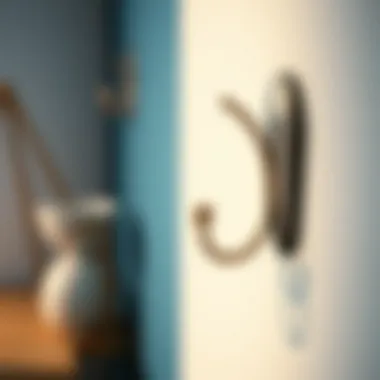
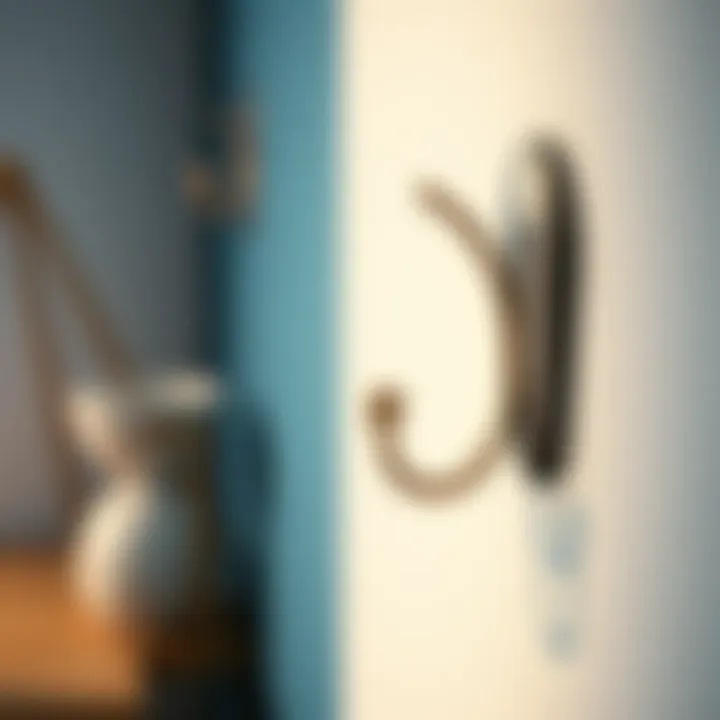
- Mild Soap and Water: A simple mix of mild dish soap and warm water can do wonders. Use a soft cloth or sponge to gently wipe the surface of the hook as well as the area around it. Cleanliness helps preserve both the adhesive and visual appeal.
- Isopropyl Alcohol: For a more thorough cleaning, rubbing alcohol can be ideal. Dampen a cloth with isopropyl alcohol and wipe down the hook and the surface. This method effectively removes stubborn residues that soap might not handle.
- Avoid Harsh Chemicals: Steer clear of abrasive cleaners or heavy-duty chemicals. They can damage the surface of the adhesive, leading to a premature decline in performance.
"Keeping your hooks clean can prolong their usage and enhance the overall aesthetic of your space."
Refreshing Adhesiveness
Sometimes, even the best hooks can lose their grip over time due to dust buildup or environmental factors. That's where refreshing their adhesiveness comes into play. Here are some handy tips:
- Re-clean the Surface: If you notice your hook is not sticking as it should, start by cleaning both the hook and the wall surface again. This helps remove any remaining dirt that might be interfering with the adhesive.
- Use a Low-Tack Adhesive: Some people find benefit from applying a temporary adhesive that’s low-tack to give the hook a little boost. Just make sure it’s compatible with your wall surface and not too sticky to damage paint or wallpaper.
- Give It Time to Rest: After reapplying or refreshing the adhesive, it’s often a good idea to avoid putting weight on the hook for a few hours. This allows for optimal bonding to take place, ensuring a tight grip on your items.
Proper maintenance and care of self-adhesive wall hooks are crucial for both their functionality and the style they bring to your space. Regular cleaning and refreshing methods can significantly enhance their performance, helping you get the most out of these handy tools. Keeping them in shape not only benefits the products but also complements the aesthetics of your interiors.
Aesthetic Considerations
Aesthetic considerations play a pivotal role in the decision-making process when it comes to selecting self-adhesive wall hooks. These seemingly simple tools serve a dual purpose: not only do they provide functionality, but they also contribute significantly to the visual appeal of a space. The ability to harmonize aesthetics with utility ensures that hooks can complement various decor styles, adding character without overwhelming the environment.
When choosing wall hooks, one must consider the overall design language of the room. From color schemes to theme consistency, every detail counts. A well-placed self-adhesive wall hook can become a focal point, drawing the eye while also serving a practical purpose. By thoughtfully integrating these elements into a home or office, you can create an organized yet stylish ambiance.
Color Coordination and Style Matching
Color coordination is crucial in making self-adhesive wall hooks blend seamlessly into their surroundings. For instance, opt for hooks that mirror or complement the hues of wall art or furniture. If your living room is adorned in soft pastels, hooks in muted tones or soft metallic finishes can enhance the overall unity of the space.
Additionally, style matching ensures that the wall hooks resonate with your chosen decor style. For example:
- Modern Interior: Sleek, minimalistic hooks in black or chrome can accentuate the clean lines characteristic of modern spaces.
- Industrial Lofts: Selecting hooks with a rustic, weathered finish aligns beautifully with the raw textures of industrial style.
- Traditional Homes: Vintage-style hooks in ornate designs can add a classic touch, providing charm and history to the decor.
By being mindful of color and style, hooks can go from mere utility items to essential elements of sophisticated design, enhancing the aesthetics of the room rather than detracting from them.
Incorporating Hooks in Interior Design
Incorporating self-adhesive wall hooks into interior design goes beyond just hanging items—they serve as statement pieces that can define a room's personality. When thoughtfully utilized, the arrangement of hooks can contribute to the rhythm and flow of the space.
Here are some strategies for making the most of wall hooks:
- Group Arrangement: Create a visually appealing grouping of hooks at varying heights. This approach not only maximizes vertical space but also creates a dynamic visual interest.
- Integrated Art: Consider designing a gallery wall that includes hooks as part of the display. Personal items like hats or bags can act as both decorative elements and functional accessories.
- Zone Creation: In larger rooms, hooks can help to demarcate different functional zones. For example, in a mudroom, a series of hooks can effortlessly delineate the transition from outdoor to indoor space.
Ultimately, the art of incorporating self-adhesive wall hooks lies in envisioning them as more than just tools; they can embody creativity, organizational efficiency, and even personal expression.
"A well-placed hook can transform mere functionality into a work of art, elevating both style and order."
For further reading on design practices, you can explore resources like Wikipedia or Britannica, which provide valuable insights into the principles that guide effective interior decoration.
Sustainability and Ethical Sourcing
In today's world, where environmental concerns are gaining traction, the choice of materials in everyday products like self-adhesive wall hooks has become paramount. Sustainability and ethical sourcing aren't just buzzwords; they're essential considerations for consumers who are becoming increasingly conscientious about their purchases. When exploring self-adhesive wall hooks, understanding their impact on the environment and the communities involved in their production adds another layer to the decision-making process.
Eco-Friendly Materials
The materials that go into making self-adhesive wall hooks can vary widely, from plastics to metals to more sustainable choices like bamboo or recycled materials. Choosing eco-friendly materials can reduce the carbon footprint associated with production and disposal. For instance, hooks made from biodegradable plastics or sourced from renewable resources help in diminishing the impact of plastic pollution, which has become a critical environmental issue.
Benefits of Eco-Friendly Materials:
- Reduced Environmental Impact: These materials often require less energy to produce and fewer harmful chemicals.
- Sustainability Certifications: Look for products that have ecological certifications, as they ensure a responsible manufacturing process.
- Durability: Many eco-friendly materials are surprisingly robust. Utilizing these materials doesn’t mean sacrificing strength for sustainability.
If you're on the lookout for wall hooks that align with your values, consider brands like 3M or Command, which prioritize eco-conscious practices. Both companies have made notable strides in offering environmentally friendly adhesive solutions, catering to a clientele that values sustainability.
Impact on Reducing Waste
One of the more appealing aspects of self-adhesive wall hooks is their potential role in reducing waste. By design, they minimize the need for nails, screws, or other fixtures that require drilling into walls, which can lead to permanent damage. When a self-adhesive hook is removed properly – a process that often leaves no residue – it supports a form of environmentally friendly living by preserving the integrity of walls and, thus, reducing the need for repairs or repainting.
Moreover, there’s a notable advantage in warehouses and retail environments that implement self-adhesive wall hooks effectively: efficient organization can lead to reduced product waste. By utilizing wall space smartly, businesses can optimize storage and display areas, which in turn can lower inventory loss and waste.
"Making environmentally conscious choices today can lead to a more sustainable tomorrow."
In sum, sustainability and ethical sourcing of self-adhesive wall hooks not only contribute to minimizing waste and preserving resources but also resonate with an increasingly aware consumer base. As we continue navigating through our daily lives, incorporating these thoughtful choices can genuinely make a difference.
By analyzing the sources of where our products come from and choosing materials that echo our values, we shape a market that prioritizes long-term benefits over short-term gains.
Comparative Analysis with Other Hanging Solutions
When it comes to wall-mounted storage and display options, self-adhesive wall hooks have gained popularity for their ease of use and versatility. However, it is advantageous to consider other hanging solutions too. Evaluating various mounting options offers insights into functionality, aesthetics, and practicality.
Nails and Hooks
Traditional nails and hooks present one of the oldest hanging solutions used in households and workplaces. Here’s a closer look:
- Durability: Nails are laudable when it comes to holding heavy items. If you are hoisting a painting or a significant wall sculpture, nails can be more reliable than lighter adhesive options.
- Installation: The process of installing nails demands more effort and skills than self-adhesive hooks. It typically involves hammering, measuring, and sometimes requires patching holes if items need to be relocated.
- Wall Damage: This is where nails fall short. They can leave visible holes and damage the wall's surface, making them a less appealing choice for renters or those who frequently change their wall decor. Meanwhile, self-adhesive hooks can be removed without damaging the surface.
In essence, while nails and hooks may be suitable for heavy-duty needs, they lack the flexibility and ease of application found with self-adhesive options. Consider them a trade-off between strength and damage avoidance.
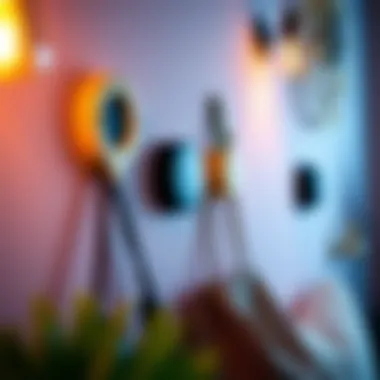
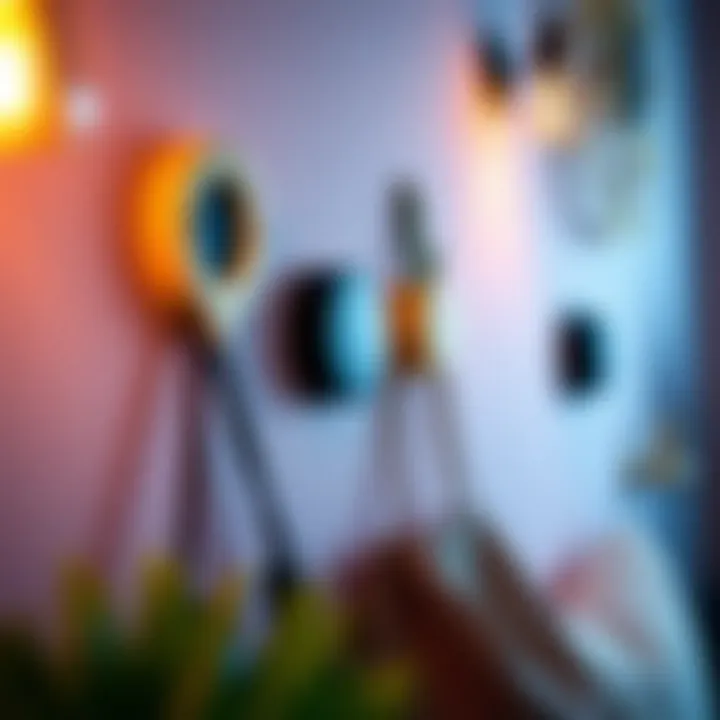
Magnetic Hooks
On the more modern side of the spectrum, magnetic hooks have emerged as another hanging solution. They possess their strengths and peculiarities:
- Versatile Usage: Magnetic hooks can be repositioned easily without any tools or surface damage. Simply move them around until you find that perfect spot.
- Strength: The holding power of magnetic hooks largely depends on both the strength of the magnet and the metallic surface. They work well on fridges and metal shelves, but using them on other surfaces, like drywall or wood, is not an option.
- Limitations in Style: While magnets come in myriad shapes, their aesthetic variety is often geometrical and might not blend well with more decorative styles.
In comparison, although magnetic hooks showcase convenience and flexibility, self-adhesive wall hooks offer a broader range of usability across different surfaces without worrying about the limitations posed by magnetic fields.
When choosing a hanging solution, consider your needs carefully. Each option presents unique functional benefits while having distinct aesthetic implications.
Ultimately, self-adhesive wall hooks stand as a middle ground. They present a solution that covers a variety of requirements—from casual hanging of light objects like scarves to robust support for items such as keys and kitchen utensils.
Closure
By conducting this comparative analysis, one can appreciate not only the practicality of self-adhesive wall hooks but also the broader context of their place among other hanging solutions. Knowing the strengths and weaknesses of nails, conventional hooks, and magnetic alternatives permits more informed decisions based on specific needs and settings.
Consumer Considerations
When thinking about wall decoration and organization, the choice of hooks may not seem like a monumental decision, yet it carries several implications that can significantly influence user satisfaction. Understanding consumer considerations helps individuals make informed choices about self-adhesive wall hooks, ensuring that their selections align with both functionality and personal aesthetic.
One major aspect consumers should think about is space usage. The size of the area where the hook will be placed can dictate everything from the type of hook needed to how many can fit without leaving a cluttered impression. Recognizing the specific needs of a space can greatly affect organization and style—after all, a hook that doesn't quite fit both visually and practically could disrupt the desired ambiance.
Additionally, it's crucial to assess intended usage. Are these hooks being used primarily for functionality or for decorative purposes? Self-adhesive hooks come in a variety of designs, from minimalist to ornate. The intended purpose will guide the choice; a simple piece may be all that's needed for holding keys, while a more artistic design could serve as a focal point in a room.
"The right self-adhesive wall hook can be the unsung hero of your interior design, marrying functionality with style effortlessly."
Beyond aesthetics and usage, durability and material play a crucial role. Consumers ought to consider what materials best suit their environment. For instance, a bathroom might require moisture-resistant hooks, while a living room may allow for more traditional finishes. Awareness of these factors enables better selection and ultimately contributes to greater satisfaction and longevity of the product.
Assessing Your Needs
Prior to purchasing self-adhesive wall hooks, a detailed evaluation of one's needs is essential. Start by considering the weight of the items planned to hang. Each hook comes with a weight limit, which, if overlooked, can lead to frustration and potential damage to both the hook and wall. It's wise to jot down the heaviest items intended for use before making a selection.
Identifying the style of one's decor is another key factor. Selecting hooks that blend seamlessly into the surrounding environment enhances both utility and aesthetics. Hooks that clash with the room’s theme can be an eyesore, undermining the entire decor.
Lastly, contemplate the frequency of use. If the hooks are for daily items, a design that allows for easy access will be more beneficial than one that offers a more decorative function without practicality.
Budget Implications
Budget is an unavoidable consideration that shapes consumer choices across all product categories, and adhesive wall hooks are no exception. They vary widely in price, from affordable options suitable for students to premium designs geared towards interior enthusiasts. Thus, setting a realistic budget not only aids in narrowing selections but also in prioritizing quality over quantity.
Investing in higher-quality materials may seem like a larger immediate expense, yet it often results in longer-lasting satisfaction and usability. Customers should factor in how often they’ll need to replace cheaper alternatives. This strategic aspect of budgeting ensures a more substantial return on investment in the long run.
It’s also important to keep an eye on sales and promotions. Many retailers occasionally run discounts, making it easier for consumers to snag quality hooks without straining their finances. Never underestimate the value of timing when making purchases—seasonal sales can offer potential savings.
Finally, don't forget to consider costs related to installation. Self-adhesive hooks often save time and money by eliminating the need for additional materials or professional assistance. They can provide an economical solution, especially for renters not wanting to lose their security deposit over wall damage.
When making decisions about self-adhesive wall hooks, weighing each of these factors ensures that choices are not only suitable for the immediate space but also cater to long-term satisfaction and functionality.
Trends in Adhesive Hook Design
The trends influencing adhesive hook design have transformed these once basic products into essential tools that reflect personal style and evolving technology. The modern consumer craves not just functionality but also aesthetic appeal, making the design aspects of these hooks critical in purchasing decisions. As self-adhesive wall hooks become more prominent in interior design, understanding these trends provides insights into their ongoing development and practical applications.
Innovative Styles
These days, self-adhesive wall hooks come in a wide variety of styles, mirroring the diverse tastes of consumers. From sleek, minimalist hooks that seamlessly blend into the backdrop to bold, sculptural pieces that serve as conversation starters, the choices are vast.
Some popular innovations include:
- Geometry-Based Designs: Many recent styles utilize geometric shapes, appealing to a modern aesthetic. The sharp angles or soft curves can add an artistic touch to any wall.
- Nature-Inspired Elements: Hooks shaped like leaves or branches are gaining popularity, infusing organic shapes into interiors to create a more serene atmosphere.
- Color Options and Textures: There's a burgeoning trend towards bright, playful colors or textured finishes that add depth. The use of materials like matte metals or elegant wood-grain textures enhances tactile appeal, making these hooks not just functional but decorative.
Such innovations allow consumers to select hooks that not only serve their intended purpose but also align with their personal design philosophy. They can add flair to spaces from the kitchen to the living room, ensuring that practicality does not overshadow style.
Functional Enhancements
Beyond mere appearances, functional enhancements play a pivotal role in the design evolution of self-adhesive wall hooks. Today’s hooks boast features that enhance their usability, proving that function and style can coexist harmoniously.
Some noteworthy enhancements include:
- Improved Adhesive Technology: Recent advancements in adhesives offer stronger bonds while being gentle on surfaces. This ensures that hooks remain securely mounted despite the weight they bear, delivering peace of mind to users.
- Weight Distribution Features: Many modern hooks come equipped with design elements that help distribute weight more evenly, preventing damage to walls. This technology is particularly beneficial in commercial settings where hooks may see high traffic.
- Removability and Reusability: Innovations in adhesive materials allow for easy removal and reapplication. This feature caters to a transient lifestyle, enabling users to rearrange their environments without stress or fear of wall damage.
These functional enhancements make self-adhesive wall hooks a practical and desirable choice in various applications, from residential settings to retail environments. As such, staying abreast of these trends is essential for consumers, designers, and retailers alike, helping them choose the best products that fit their needs.
"The trend in self-adhesive wall hooks is as much about what’s ‘in’ as it is about practical day-to-day living; it reflects a balancing act between aesthetic fulfilment and functional necessity."
Finale and Final Thoughts
The exploration of self-adhesive wall hooks extends beyond mere functionality into a realm where design truly meets utility. These nifty little accessories have become essential companions in our quest for organized living spaces. Their appeal cannot be overstated; they provide a blend of practicality, versatility, and aesthetic enhancement that redefines how we utilize wall space.
In summary, this article has aimed to shed light on several crucial aspects of self-adhesive wall hooks:
- Types and Materials: From plastic to metal, understanding the different materials can influence choice based on durability and design preference.
- Ease of Use: The straightforward installation process makes them attractive to anyone, whether you’re a seasoned DIYer or a novice.
- Aesthetic Contribution: Wall hooks can serve as statement pieces or functional elements that complement various interior styles, thus enhancing the overall decor.
- Sustainability: With the growing demand for eco-friendly solutions, many manufacturers are now producing hooks from sustainable materials, which aligns with contemporary ethical considerations.
- Weight Management: Knowledge of weight capacities is vital for safety and functionality, ensuring that these hooks maintain their promise without damaging walls or dropping items.
"Proper installation and load management can turn a fleeting organizational fix into a long-term solution for clutter-free spaces."
As we contemplate the future of wall hook design, it’s clear that innovation will drive enhancements in both form and function. We are on the brink of even stronger adhesives, more creative designs, and integrations with smart technology. Whether be they hooks that can adjust according to weight or those that utilize advanced adhesives for various surfaces—the potential is limitless.
The pressing need for clutter solutions in our increasingly compact living environments ensures that self-adhesive wall hooks will stay relevant. Thus, design enthusiasts, retailers, and everyday consumers alike should keep an eye on these evolving trends to not only elevate their spaces but also enrich their daily lives. Self-adhesive wall hooks are no longer just a temporary fix; they have established their rightful place in the toolkit of modern organization and design.



